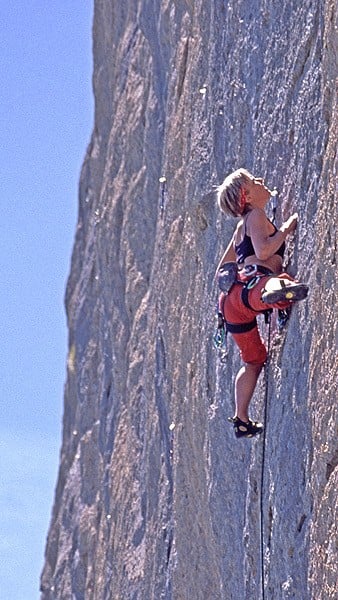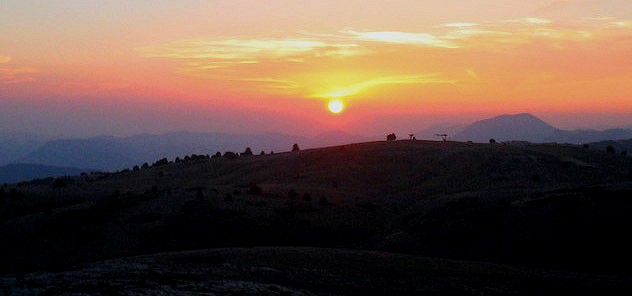
My first day at Ceuse was not an auspicious start. The campsite and crag were full of skinny, sunbronzed pretty-boys and girls, showing off their pecs whilst fixating you with a hostile blank sport climber's glare: "I've been falling off the last move of a F8b+ for 3 weeks now and I'm just about to give it another go and you are daring to look in my direction?" The slog up was as exhausting as I'd expected. The warm-up F6a was just as tiring. The small sliver of time before the sun started baking the crag was disappointingly short. The next easy sector was crowded and polished, queuing for the few shady routes was hardly fun. The guidebook topos, consisting of a series of parallel lines on a blank page with the occasional horizontal line that could be a roof / ledge / break / flake / seam if it did actually correspond to reality, were spectacularly hopeless. All those beautiful streaked pocket lines were so many grades out of reach there was no point even thinking about them. Even the easy routes felt desperately hard. I failed on two F6bs. Then the torrential storm began...
This sucked. I wanted to give up climbing, go home, and take up golf.
But I didn't (the golf option still tempts me though). The next day I spent a relaxing morning sulking at the campsite, hiked up after this respite, climbed two 6b+s and found them both fine and very enjoyable. It was on again.
The climbing: Ceuse is rightly famous for its hard routes and if you're climbing F7b it could be the trip of a lifetime. Great, but that's irrelevant to 90% of people who will read this. Back to the real world of low-mid grades - we're talking F6s here. There is climbing in the lower grades, and it is good. Not radically different to the European norm, nor any better than Buoux or Siurana or Gandia, but it's good. You will need to be climbing F6b to get the most out of a visit. If you're climbing F6a, you could get a day or so. F6b, you'll get a few good days. F6c, you could have a good week there - I did. This is onsighting of course. Working stuff that's harder, there's loads of potential, knock yourself out - it will be as much fun as falling off that last move for a whole week.
The climbing style is sport limestone, naturally. Mostly single pitch, from 15 to 30m, although there are some multipitches - these often have a sneaky harder pitch in them but might be fun for an adventure. The rock is invariably good but can be polished and a bit chalky on some of the easier routes. Head away from the well-used areas and the feel often improves. In the F6s, expect a sustained mixture of vertical walls, occasional slabs (that often provide a shock at the top of some routes) and gentle bulges - usually climbed on pockets and flaky edges and nubbins. There are a few small roofs but all the really steep stuff is the terrain of the F7b climber. The routes are reasonably bolted with good bolts, but often you'll clip a bolt from a big hold and then find it below your feet on the subsequent crux...hmmm... The grades are generally consistent but can feel a little stiff - possibly the combination of 2000m altitude, 1hour and 500m ascent of walking, and chasing the elusive shade all day - just maybe?
Ceuse is also famous for being a summer climbing venue in an area that's guaranteed soaring 35'C temperatures, due to the altitude - we were there mid-late July and got to test this quite well. The good news is the altitude does make a difference, at night and in the shade it is distinctly fresh. The bad news is the crag basks in the sun all day so a cunning plan is needed, as follows: For a full day, get up early, walk up in the shade. Climb at Thorgal until the sun hits it. Watch the antics at Cascade for a bit, then walk around in the full baking heat to Biographie. Chill out here in the deep shade and have a siesta. In the mid-afternoon, head to the right end of Demi-Lune and warm up again. By now the main easier sectors will be shady so get ticking - although it is worth waiting until late evening (cooler rock) for your harder challenges. After a couple of long days of this you'll probably end up having just morning, or more likely, just evening sessions! Note that if there are evening storms, there is plenty of shelter and the rock dries quickly.
To round off one evening, it is well worth heading up the Via Ferrata just right of Sector Pont Sur L'Infini to the top of the crag - this can be led if needed, otherwise it's about E2 4a! Not many people seem to go up to the scenic plateau on top, but the view of the sunset and surrounding terrain is unparalleled. There is even some good bouldering potential up there...
Top ten picks:
Petit Monstre F6a - one of the best actual features at Ceuse, an undulating runnel, which happens to climb very nicely.
Coup De Blues F6a+ - another proper feature climb, linking flakes and ramps with some big moves and committing climbing, very good.
La Femme Piege F6b - a nice steady route that's a good introduction to Thorgal's specific climbing.
Chant Cristal F6b - F6b+ in the guide but it feels like F6b if you get the right sequence - a technical and crimpy crux amongst nice gentler climbing.
Route left of Rumble Gish (?) F6b+ - the next step from La Femme Piege, a bit trickier, a bit more sustained, and then there's the slab finish....great value.
Harley Davidson F6b+ - a bit of a classic wall climb with a sustained and exciting crux.
Equinoxe F6c - a great and full value route, those who like gut-busting grit roofs will enjoy the hernia inducing start, whilst there's still a delicate slab and cranky wall to come.
Silmarils F6c - very nice steady climbing in a quiet area. Good rock and some great moves.
Zagreb F6c - another classic, and with good reason. Generally excellent climbing on good holds, with some wild pulls.
Medicine Douche F6c+ - a taster of the steepness that F6 climbers miss out on. The Cascade warm-up so it's well polished, but this doesn't detract from positive but beefy pulling.
The Beta:
Access: The easiest approach is from Gap, the nearest urban centre and the place to stock up on food (several supermarkets) and climbing / camping gear (Decathlon and/or the climbing shop just off the town square). Gap is reachable from many airport destinations (Nime, Marseille, Nice, Grenoble) in a few hours. From Gap, the Ceuse massif is unmissably imposing, but the route is a bit slower. Follow the D994 out of Gap until you reach La Freissinouse (home to a superb pizza shack - an essential mid-trip respite from camp food!). Turn left onto the D19 and follow this several increasingly windy kilometres to La Sigoyer. At the end of the village, turn right and follow this windier road, trending leftwards, for a few more kilometres until the campsite is signposted.
Accomodation: Stay at the Les Guernis campsite, either camping or in their caravans (the latter weren't tested). Simple as that. A bargain at 4.50 Euros per person per night. For that you get a reasonably pleasant if very climbery site, fridges, ping-pong table, woody, lots of washing facilities including showers that are invariably cold late at night. There is also a shop with a reasonable selection of only slightly over-priced essentials. The farmer in charge is full of charming Gallic belligerence and apparently likes to be notified of new arrivals promptly.
Top tip: In summer, check out where the sun will rise (from the entrance side of the site) and pick a shady spot accordingly. Unless you like a tent-sized sauna at 6am...
The walk: Ceuse, perched on top of a broad cone of a hill, is famed for it's walk-in. The bad news is: Yes, it is as long and tiring as you'd expect - roadside clipping this ain't. The good news, however, is: It doesn't go straight up that hill, instead it follows a series of long zig-zags at a relatively gentle angle. Persist with the first steep-ish bit to the damp gully, and it's almost pleasant after that - around 50 - 60 minutes depending on fitness and sector. It takes about 15 - 20 minutes to walk between the main sectors of Cascade to Demi Lune. To reach the crag from the campsite, follow the trail behind the horse barn, through paddocks and electric fences, until it turns right towards the tree-line. Follow a roughish track until the damp gully and milder ground. When the large trail is reached, cross diagonally right and continue on a long zigzag. On the right hand bend of that zig-zag, you have a choice: For the left hand sectors (morning shade), step left and head directly up a brief and steep track, turn left onto a flat contour track, through a gate and after a few minutes head directly up rocky terrain to Cascade. For right hand sectors (evening shade), continue on the shallow diagonal track after the right hand bend, ignore a sharp left, and take the next diagonal left fork. Follow this contour path until you're beneath the sector of your choice, then up directly.
Top tip 1: Bring some tunes for the walk-in particularly if you're going at different paces. I recommend dark drum'n'bass or hard trance for maximum psyche, others may differ.
Top tip 2: If your knees are up to it, try running back down. It is shockingly easy and fast and untiring - in fact it's almost fun!
Stashing: A common technique to tame the daily slog is to stash most of one's climbing gear at, or close to, the crag. Naturally with leaving stuff lying around, some people get it stolen - those people who will leave things in plain view, next to tracks or under commonly passed boulders. Don't do that. There is a whole hillside of forest to hide stuff in, and it's very unlikely anyone would be able to find it if you're careful. We left our bags at the junction where the tracks to the different sectors split, 20-30m into the forest and well hidden under the undergrowth - they were safe for the whole 8 days, and any potential thief would have had to comb the forest metre by metre to stumble across them. Use your nouse and it should be fine.
Top tip: Plan carefully what you need to bring up and down. If the Cascade waterfall is even trickling, there will be a supply of deliciously pure and cold water, so you can bring up a bare minium of stuff to the stash each day.
The guide: Is available from the campsite and climbing shops, but is farcical. It's shockingly bad - parallel lines on an otherwise almost entirely blank page. What makes it even sillier is that it would take someone about an hour to sketch in a few of the prominent features along all the main areas, and actually make it functional. But it isn't. Luckily the names are on the rock for many of the harder routes. Unluckily the easier routes have sparser name markings and they are sometimes hidden. A good plan is to spend a little while at each sector finding out what is what and getting some information from the veterans who know which routes are which. There is an online guide in Czech but it is incomplete.
Rest days: There's plenty to do in the area ranging from merely sunbathing in a spectacular enviroment to all sorts of other activities in the surrounding mountains (including gliding probably, given how often gliders "buzz" the crag - an inspiring spectacle). Highly recommended is a visit to the Gorges de la Méouge swimming hole (near Laragne Monteglin) for an entertaining blend of cliff jumping, waterfall swimming, deep water bouldering and other such frivolity. A day here was regarded as a highlight of the trip, and possibly the least restful rest day ever. There is also a sedate family swimming area nearer Gap at Les Trois Lacs, with go-karting nearby that looked particularly fun.
Other climbing: You're in the middle of the major French sport climbing hub! How long have you got on your visit? There are a large number of crags in the Ceuse guidebook, including some big multi-pitch stuff. Near the area are good places like Orpierre and Sisteron, head a couple of hours further afield and a vast choice opens up with Buoux, Verdon, Volx, Orgon, Mouries, Fontveille, etc etc. It's tiring just to think about!
Good luck!
Note:
This article is written to compliment Mark Glaister's UKC article, in that it highlights the potential at lower grades and gives some further hints and trips for a smoother Ceuse visit. Ceuse is a great crag but not a simple one - I was fortunate to go with people who knew it well, but if I hadn't, then I'd have been glad of what you've just read.




Comments